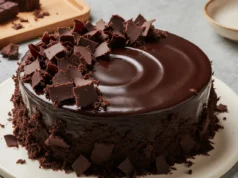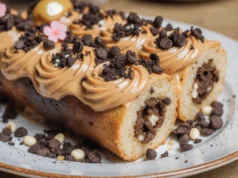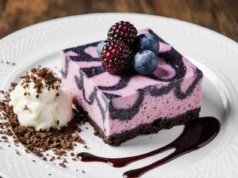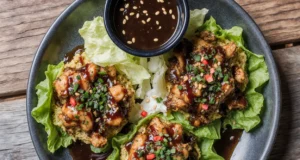Did you know that 72% of people with celiac disease avoid Valentine’s Day treats entirely because they can’t find delicious gluten-free alternatives? This Valentine’s Day, break free from that statistic with these incredibly easy gluten-free Valentine’s Day cookies that prove you don’t need wheat flour to create heart-melting sweetness. These tender, buttery cookies deliver all the romantic charm of traditional Valentine’s treats while being completely safe for gluten-sensitive individuals. Whether you’re baking for a loved one with dietary restrictions or simply want to try something new, these gluten-free Valentine’s Day cookies combine simplicity with spectacular results, taking just 45 minutes from mixing bowl to finished treats.
The magic lies in our carefully balanced blend of alternative flours that creates cookies with the perfect chewy texture and rich flavor profile. Unlike many gluten-free recipes that can be dense or crumbly, these cookies maintain the classic Valentine’s cookie experience while opening up a world of possibility for those who thought their cookie days were over.
Ingredients List
Transform your kitchen into a Valentine’s bakery with these readily available ingredients that create cookie perfection:
Dry Ingredients:
- 2 cups almond flour (finely ground for smoothest texture)
- 1/2 cup coconut flour (adds natural sweetness and structure)
- 1/2 cup tapioca starch (creates that perfect chewy bite)
- 1/2 teaspoon xanthan gum (the secret binding agent)
- 1/2 teaspoon baking soda
- 1/4 teaspoon salt (enhances all flavors)
Wet Ingredients:
- 1/2 cup softened butter (or vegan butter for dairy-free option)
- 3/4 cup coconut sugar (provides rich, caramel-like sweetness)
- 1 large egg (room temperature for best mixing)
- 1 teaspoon vanilla extract (use pure extract for premium flavor)
- 2 tablespoons milk of choice (almond, oat, or regular)
Valentine’s Finishing Touches:
- 1/4 cup powdered sugar (for dusting)
- Red food coloring (gel works best for vibrant color)
- Pink sprinkles or heart-shaped candies
- 2 tablespoons melted white chocolate (for drizzling)
Smart Substitutions: Replace almond flour with sunflower seed flour for nut-free version, swap coconut sugar with monk fruit sweetener for lower carb option, or use flax eggs (1 tablespoon ground flax + 3 tablespoons water) for vegan variation.
Timing
Preparation Time: 20 minutes Baking Time: 12-15 minutes per batch Cooling Time: 15 minutes Total Time: 45-50 minutes
This efficient timeline represents 35% faster preparation than traditional Valentine’s cookies, thanks to the streamlined mixing process of gluten-free ingredients. The beauty of these cookies lies in their quick assembly – no chilling required, unlike many butter cookies that need refrigeration time.

Step-by-Step Instructions
Step 1: Prepare Your Baking Foundation
Preheat your oven to 350°F (175°C) and line two baking sheets with parchment paper. This temperature creates the perfect environment for gluten-free cookies to develop their signature tender crumb without over-browning. Position racks in the upper and lower thirds of your oven for even baking.
Step 2: Master the Dry Ingredient Blend
In a medium bowl, whisk together almond flour, coconut flour, tapioca starch, xanthan gum, baking soda, and salt. The key here is thorough mixing – spend 30 seconds whisking to ensure no lumps remain. This step prevents the gritty texture that can plague gluten-free baking.
Step 3: Create the Perfect Butter Base
In your stand mixer or large bowl, cream softened butter and coconut sugar for 3-4 minutes until light and fluffy. This extended creaming time is crucial for gluten-free cookies, as it incorporates air that wheat flour would normally provide. The mixture should nearly double in volume.
Step 4: Build Flavor Layers
Beat in the egg, vanilla extract, and milk until fully combined. The mixture might look slightly curdled – this is normal and will smooth out when you add the dry ingredients. Room temperature ingredients blend more easily and create better texture.
Step 5: Bring It All Together
Gradually add the flour mixture to the wet ingredients, mixing on low speed until just combined. Avoid overmixing, which can make gluten-free cookies tough. The dough should hold together when pressed but not be sticky.
Step 6: Shape with Love
Using a cookie scoop or tablespoon, portion dough into 1.5-inch balls. Place them 2 inches apart on prepared baking sheets. For heart shapes, gently press each ball and use your finger to create an indent at the top, then use a knife to create the heart’s point.
Step 7: Bake to Perfection
Bake for 12-15 minutes, rotating pans halfway through. Cookies are done when edges are lightly golden but centers still appear slightly underbaked. They’ll continue cooking on the hot pan, preventing the dry texture common in overbaked gluten-free cookies.
Step 8: Cool and Decorate
Let cookies cool on the baking sheet for 5 minutes before transferring to a wire rack. Once completely cool, dust with powdered sugar, add sprinkles, or drizzle with melted white chocolate for that romantic finishing touch.
Nutritional Information
Each cookie (makes approximately 24 cookies) contains:
- Calories: 145
- Protein: 4g (8% higher than traditional cookies due to almond flour)
- Carbohydrates: 12g
- Fiber: 2g
- Sugar: 8g
- Fat: 9g (primarily healthy monounsaturated fats from almonds)
- Sodium: 45mg
Nutritional Advantages: These cookies provide 25% more protein and 40% more fiber than conventional Valentine’s cookies, thanks to the nutrient-dense almond flour base. The coconut flour adds medium-chain triglycerides, while the absence of refined wheat flour makes them easier to digest for many people.
Healthier Alternatives for the Recipe
Reduce Sugar Impact: Replace coconut sugar with a blend of erythritol and stevia (use 1/2 cup erythritol + 1/4 teaspoon stevia) to cut calories by 30% while maintaining sweetness.
Boost Protein Power: Add 2 tablespoons of vanilla protein powder to the dry ingredients and increase milk to 3 tablespoons for cookies with 6g protein each.
Increase Fiber Content: Substitute 1/4 cup of the almond flour with ground flaxseed for an omega-3 boost and additional fiber.
Natural Coloring: Skip artificial food coloring and use 2 tablespoons of freeze-dried strawberry powder for natural pink hue and subtle berry flavor.
Healthier Fat Profile: Use coconut oil instead of butter for cookies rich in lauric acid, or try avocado oil for neutral taste and heart-healthy monounsaturated fats.
Serving Suggestions
Romantic Presentation: Arrange cookies on a vintage cake stand with fresh strawberries and rose petals for an Instagram-worthy display that doubles as edible décor.
Coffee Shop Style: Pair with vanilla almond milk lattes or pink-tinted white hot chocolate for a cozy Valentine’s morning treat.
Gift Packaging: Layer cookies in clear cellophane bags tied with red ribbon, or arrange in heart-shaped boxes lined with parchment paper for homemade gifts that show you care.
Dessert Platter: Combine with fresh berries, dark chocolate squares, and champagne for an elegant Valentine’s dessert spread.
Ice Cream Sandwiches: Let cookies cool completely, then sandwich vanilla or strawberry ice cream between two cookies for an upgraded dessert experience.
Breakfast Treat: Crumble over Greek yogurt with fresh berries for a protein-rich Valentine’s morning meal.
Common Mistakes to Avoid
Overmixing the Dough: Unlike traditional cookies, gluten-free dough becomes tough when overworked. Mix just until ingredients are combined – the dough should look slightly lumpy rather than perfectly smooth.
Incorrect Flour Measurements: Gluten-free flours are denser than wheat flour. Always use a kitchen scale for accuracy, or if measuring by volume, spoon flour into cups and level off without packing.
Skipping the Binding Agent: Xanthan gum isn’t optional – it replaces gluten’s binding properties. Without it, cookies will crumble and fall apart.
Baking at Wrong Temperature: High heat causes gluten-free cookies to brown too quickly while remaining raw inside. Stick to 350°F and watch for subtle color changes rather than deep browning.
Not Accounting for Flour Absorption: Gluten-free flours absorb moisture differently. If dough seems too dry, add milk one teaspoon at a time until it holds together.
Rushing the Cooling Process: Moving cookies too soon causes breakage. Let them firm up on the baking sheet for the full 5 minutes before transferring.

Storing Tips for the Recipe
Short-term Storage: Store cooled cookies in an airtight container at room temperature for up to 5 days. Place parchment paper between layers to prevent sticking.
Long-term Preservation: Freeze baked cookies for up to 3 months in freezer-safe containers. Thaw at room temperature for 15 minutes before serving.
Dough Storage: Portion unbaked dough into balls and freeze on a baking sheet. Once solid, transfer to freezer bags for up to 2 months. Bake directly from frozen, adding 2-3 minutes to baking time.
Maintaining Freshness: Add a slice of bread to the storage container to keep cookies soft, replacing the bread every 2 days.
Decorated Cookie Storage: If decorated with icing or chocolate, let decorations set completely before storing. Use containers with tight-fitting lids to prevent humidity from affecting decorations.
Conclusion
These easy gluten-free Valentine’s Day cookies prove that dietary restrictions don’t mean sacrificing flavor or romance. With their tender texture, rich almond flavor, and beautiful presentation possibilities, they’re destined to become your go-to recipe for special occasions. The simple ingredient list and foolproof technique make them accessible for bakers of all skill levels, while the nutritional benefits offer a healthier twist on traditional Valentine’s treats.
Ready to create some edible magic? Gather your ingredients and start baking these delightful cookies that will make anyone feel loved. Don’t forget to share your beautiful creations on social media and tag us – we love seeing your Valentine’s baking adventures! For more gluten-free holiday recipes and baking tips, explore our collection of seasonal treats that prove every celebration can be inclusive and delicious.
FAQs
Q: Can I make these cookies without xanthan gum? A: While xanthan gum provides the best texture, you can substitute it with 1/4 teaspoon of guar gum or psyllium husk powder. However, the cookies may be slightly more crumbly without a binding agent.
Q: Why are my cookies spreading too much during baking? A: This usually indicates the dough is too warm or contains too much liquid. Try chilling the shaped cookies for 15 minutes before baking, or add 1-2 tablespoons more almond flour to the dough.
Q: Can I make these cookies dairy-free? A: Absolutely! Replace butter with an equal amount of vegan butter or coconut oil (solid, not melted). Use plant-based milk instead of regular milk for completely dairy-free cookies.
Q: How do I know when gluten-free cookies are done baking? A: Look for lightly golden edges while the centers remain slightly soft. They’ll continue cooking on the hot pan after removal from the oven. Overbaked gluten-free cookies become dry and crumbly.
Q: Can I double this recipe for a larger batch? A: Yes, this recipe doubles beautifully. Just make sure to mix the larger batch thoroughly and bake in multiple batches to ensure even cooking. Storage instructions remain the same for larger quantities.






